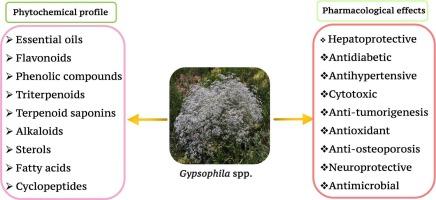关于 Gypsophila 种类的最新概述:植物化学和药理学研究
IF 2.5
3区 医学
Q3 CHEMISTRY, MEDICINAL
引用次数: 0
摘要
药用植物及其成分在预防和治疗疾病方面发挥着至关重要的作用。石竹属(石竹科)包括约 150 种开花植物,在观赏和治疗领域都具有重要价值。各种文化中的传统用法都强调了它们在治疗肝脏疾病、糖尿病和肾结石等一系列疾病方面的潜力。这些生命力顽强的植物以其娇艳的花朵和对不同环境的适应能力而闻名,含有丰富的化合物,包括酚类化合物(如类黄酮)、萜类化合物、皂甙、环肽和生物碱等非挥发性成分。此外,主要挥发性成分单萜和倍半萜具有显著的杀虫特性。石膏蕨类植物具有广泛的药理作用,包括保肝、细胞毒性、抗糖尿病、抗氧化、细胞毒性、抗炎、利尿、神经保护和抗肥胖等特性。这篇综述强调了石膏花的巨大治疗潜力,并主张进一步开展研究,特别是临床试验,以全面评估其疗效和安全性。通过整合现有知识,该综述揭示了石膏草物种作为人类健康宝贵资源的潜力,并强调了继续探索以发现新型治疗方法和干预措施的必要性。本文章由计算机程序翻译,如有差异,请以英文原文为准。

An updated overview of Gypsophila species: Phytochemical and pharmacological investigations
Medicinal plants and their consituents play a crucial role in disease prevention and treatment. The genus Gypsophila (Caryophyllaceae family), comprising approximately 150 species of flowering plants, holds significant value in both ornamental and therapeutic fields. Traditional uses in various cultures highlight their potential in treating a range of conditions, such as liver disorders, diabetes, and kidney stones. These resilient plants, known for their delicate blooms and adaptability to diverse environments, are rich in chemical compounds, including non-volatile constituents such as phenolic compounds (e.g., flavonoids), terpenoids, saponins, cyclopeptides, and alkaloids. Additionally, monoterpenes and sesquiterpenes, the primary volatile constituents, exhibit significant insecticidal properties. Gypsophila species show a broad spectrum of pharmacological effects, including hepatoprotective, cytotoxic, anti-diabetic, antioxidant, cytotoxic, anti-inflammatory, diuretic, neuroprotective, and anti-obesity properties. This review underscores the promising therapeutic potential of Gypsophila and advocates for further research, particularly clinical trials, to thoroughly assess their efficacy and safety. By consolidating existing knowledge, it sheds light on the potential of Gypsophila species as valuable resources for human health and underscores the need for continued exploration to uncover novel treatments and interventions.
求助全文
通过发布文献求助,成功后即可免费获取论文全文。
去求助
来源期刊

Fitoterapia
医学-药学
CiteScore
5.80
自引率
2.90%
发文量
198
审稿时长
1.5 months
期刊介绍:
Fitoterapia is a Journal dedicated to medicinal plants and to bioactive natural products of plant origin. It publishes original contributions in seven major areas:
1. Characterization of active ingredients of medicinal plants
2. Development of standardization method for bioactive plant extracts and natural products
3. Identification of bioactivity in plant extracts
4. Identification of targets and mechanism of activity of plant extracts
5. Production and genomic characterization of medicinal plants biomass
6. Chemistry and biochemistry of bioactive natural products of plant origin
7. Critical reviews of the historical, clinical and legal status of medicinal plants, and accounts on topical issues.
 求助内容:
求助内容: 应助结果提醒方式:
应助结果提醒方式:


